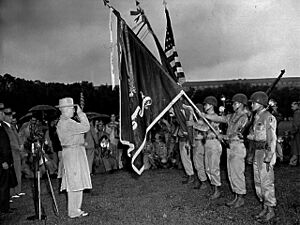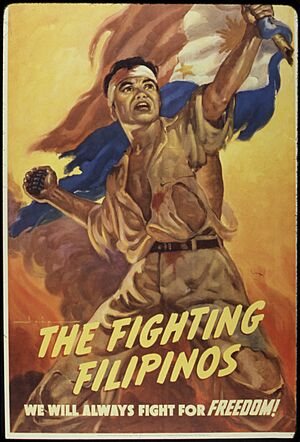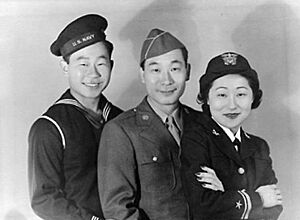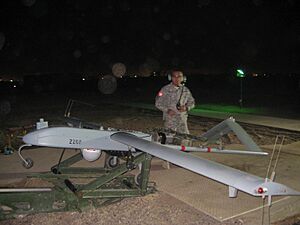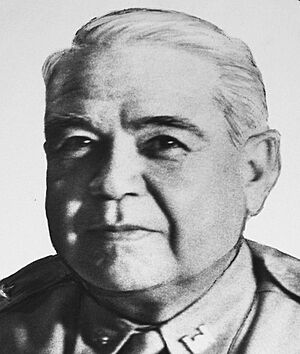Military history of Asian Americans facts for kids
Asian Americans are people in the United States who have roots in Asia. They have bravely served and fought for the United States in many wars, starting way back in the War of 1812. During the American Civil War, Asian Americans fought for both the Union (the North) and the Confederacy (the South). After that, many served in the U.S. Navy until the Philippine–American War.
In the early 1900s, Asian Americans started attending U.S. military academies. Some were even awarded the Medal of Honor, which is the highest award for bravery. During World War I, Asian Americans served in the army. After this war, their service was not widely known until World War II. In World War II, Japanese, Chinese, Filipino, and Korean Americans made very important contributions.
In 1948, the U.S. military stopped separating soldiers by race. This meant Asian American units no longer existed. Asian Americans then served in mixed military groups. They continued to show great courage in the Korean and Vietnam wars, earning more Medals of Honor. Asian Americans still serve in the military today.
Early Service (1800s)
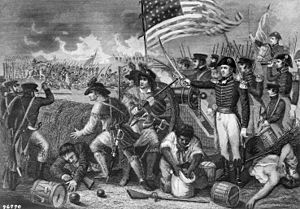
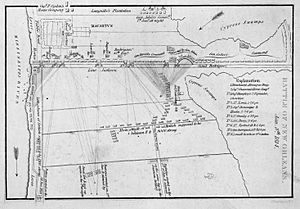
War of 1812
The first official record of Asian Americans fighting for the U.S. was in 1815. This happened during the War of 1812.
During this war, General Andrew Jackson wrote that "Manilamen" fought under his command. They helped defend New Orleans. They were led by Jean Lafitte. After the war, at least one Filipino American, Augustin Feliciano, continued to serve in the U.S. Navy. For many years after, there were no official records of Asian Americans in the U.S. military.
American Civil War
Many Asian Americans served in the American Civil War. They came from various places like China, India, the Philippines, and Hawaii. They fought for both the Union (North) and the Confederacy (South).
Chinese Americans in the Civil War
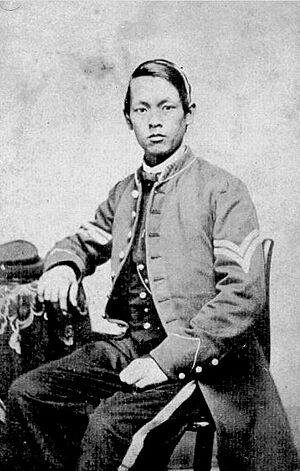
In 1861, a Chinese American named John Tomney joined the New York Infantry. He later died from wounds received at the Battle of Gettysburg in 1863.
Joseph Pierce was brought to the U.S. from China. He joined the Union Army in 1862. He fought in major battles from Antietam to Appomattox Court House. Pierce became a corporal, the highest rank for a Chinese American in the Union Army. His picture is displayed in the Gettysburg Museum.
Edward Day Cohota was born in China and served in the 23rd Massachusetts Infantry. He continued to serve in the Army for 30 years after the war. Even though he served, he could not become a U.S. citizen because of the Chinese Exclusion Act of 1882.
More than 50 Chinese Americans fought in the Civil War. Some received pensions or citizenship for their service. One example was Ching Lee, who used the name Thomas Sylvanus. He served in the 81st Pennsylvania Regiment.
Filipino Americans in the Civil War
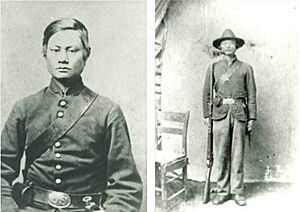
A Filipino American named Felix Cornelius Balderry served in the Union's 11th Michigan Infantry. Other Filipino Americans served in the U.S. Navy on ships like the Little Ada and the Conemaugh.
There are also stories of Filipino Americans serving with the Confederacy in Louisiana. Some fought on the C.S.S. Alabama. Many Native Hawaiians also served in the Civil War. However, records were not always clear for non-white soldiers.
Indian Americans in the Civil War
Anthony F. Gomez was born in India in 1837. He joined the United States Navy in 1863 after moving to New York. He served during the Civil War. After the war, he moved to San Francisco and continued to work for the Navy until he died in 1911.
Military Academy Graduates (1800s)
In the late 1860s, Asian students were accepted into the United States Naval Academy. Matsumura Junzo was the first to graduate in 1873. He was from Japan and served in the Imperial Japanese Navy. It took almost 40 more years for the first Asian Americans who were U.S. citizens to attend these academies.
Spanish–American War
After the Civil War, there was another quiet period for Asian American military records. This changed during the Spanish–American War. When the USS Maine ship sank, seven Japanese Americans and one Chinese American were among the casualties. Later, Japanese Americans also served on U.S. warships during the Battle of Manila Bay.
The 20th Century
Philippine–American War
In 1901, the Philippine Constabulary and Philippine Scouts were created. They helped the U.S. during the Philippine–American War. That same year, President William McKinley allowed 500 Filipinos to join the U.S. Navy.
These enlistments led to the first Asian Americans receiving the Medal of Honor. Private Jose Nisperos, a Philippine Scout, received the Medal of Honor in 1911 for protecting his group from attackers. In 1915, Fireman Second Class Telesforo Trinidad also received the Medal of Honor. He saved fellow crewmembers when a ship's boiler exploded. Trinidad is the only Asian American to receive the Navy's Medal of Honor.
Military Academy Graduates (1900s)
Vicente Lim was one of the first Asian Americans to graduate from West Point in 1914. He was a Filipino American and became a second lieutenant in the Philippine Scouts. He was part of a special program that allowed a few Filipinos to attend West Point.
In 1916, Filipinos also began to be accepted into Annapolis. Many of these graduates later served in the new Armed Forces of the Philippines.
Mexican Expedition

In the early 1900s, while World War I was happening, the U.S. focused on its southern border. Mexico was in a civil war. In 1916, the violence spilled into the U.S. when Pancho Villa attacked New Mexico. This led to the Pancho Villa Expedition, led by Major General John Pershing.
Many Chinese Mexicans helped U.S. forces during this expedition. When the mission ended, these Chinese Mexicans were in danger from Villa. Despite the Chinese Exclusion Act, General Pershing helped them resettle in the U.S. About 527 of them moved to places like San Antonio. They became known as "Pershing's Chinese."
World War I
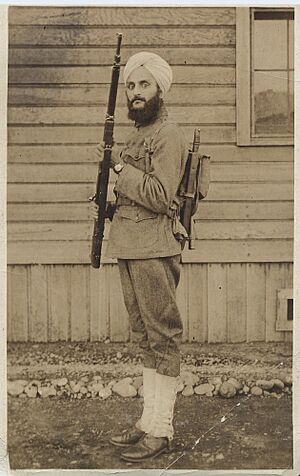
In April 1917, the U.S. joined World War I. The Philippines created its own national guard units, but they did not fight. In the U.S., a draft began. Asian Americans were drafted as "non-whites" and filled spots in the army. Most Asian Americans did not see combat.
Indian American Bhagat Singh Thind served in the U.S. Army. He was the first U.S. soldier allowed to wear a turban for religious reasons. A few Asian Americans did see combat. Private Tomas Mateo Claudio, a Filipino American, was killed in 1918. Private Henry Chinn died in the Argonne Forest. Sergeant Sing Kee received the Distinguished Service Cross. Sergeant Major Tokutaro Nishimura Slocum also served. By the end of the war, thousands of Chinese, Japanese, Korean, Vietnamese, and Filipinos had served.
After the war, many Asian American veterans were allowed to become U.S. citizens. However, some faced legal challenges. For example, 400 Japanese immigrant veterans in Hawaii had their citizenship taken away in 1922. It wasn't until 1935 that they got it back.
Between the World Wars
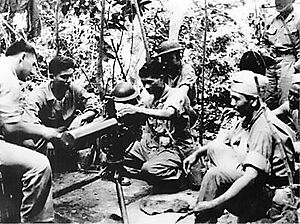
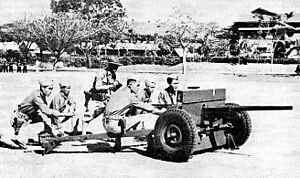
Between World War I and World War II, U.S. forces were involved in smaller actions. These included events in the Caribbean and China. During this time, many Filipino Americans served in the U.S. Navy. However, after World War I, they were mostly limited to jobs as "mess stewards" (serving food).
In 1934, Gordon Pai'ea Chung-Hoon became the first Asian American U.S. citizen to graduate from the Naval Academy. In 1940, Wing Fook Jung became the first Asian American to graduate from West Point.
In 1937, the Second Sino-Japanese War began. A Chinese American, Arthur Chin, joined the Chinese Air Force. He became the first American "flying ace" of World War II, shooting down eight enemy planes. He received the Distinguished Service Cross.
In September 1939, World War II started in Europe. The U.S. stayed neutral at first. But Americans still got involved, serving in other countries' militaries. After Japan attacked Pearl Harbor in December 1941, the U.S. officially entered the war. Asian Americans were then on the front lines as U.S. civilians and soldiers.
World War II
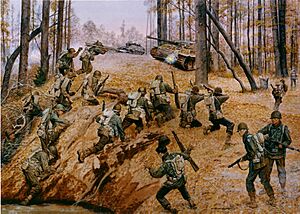
Japanese Americans
After the attack on Pearl Harbor, Japanese Americans in the Hawaii National Guard helped with rescue efforts. However, they were later disarmed because of their Japanese heritage. Many Japanese American men were classified as "enemy aliens." This policy was changed in 1943.
In 1942, 1,400 Japanese Americans from the Hawaii National Guard formed the 100th Infantry Battalion. Later, an all-Japanese American regiment was created, called the 442nd Regimental Combat Team. These units were segregated, meaning they were made up only of Japanese American soldiers, mostly led by white officers.
The 442nd Regiment became one of the most decorated units in U.S. military history. They fought bravely in Italy, France, and Germany. They even helped liberate the Dachau concentration camp. The unit earned 9,486 Purple Hearts. They also received eight Presidential Unit Citations.
Japanese Americans also helped in the war against Japan in the Pacific. They served in the Military Intelligence Service. They helped decode Japanese messages and rebuild Japan after the war. The first Asian American women in the U.S. military served in this unit. Over 33,000 Japanese Americans served in World War II. When they returned home, they still faced prejudice.
In 1946, PFC Sadao Munemori of the 442nd was given the Medal of Honor after he died in Italy. In 2000, after a review, 21 more Medals of Honor were given to members of the 442nd. One of these went to Hawaii Senator Daniel K. Inouye. In 2010, the 442nd Regimental Combat Team, the 100th Infantry Battalion, and the Military Intelligence Service received the Congressional Gold Medal.
Chinese Americans
It is estimated that between 12,000 and 20,000 Chinese American men served in World War II. About 40 percent were not citizens. Unlike Japanese and Filipino Americans, most Chinese Americans served in mixed units. They faced less discrimination.
About a quarter of them served in the U.S. Army Air Forces. Some were sent to China, Burma, and India. Another 70 percent served in the U.S. Army in various divisions. Before the war, Chinese Americans in the Navy were limited to steward jobs. This changed in May 1942, allowing them to serve in other roles. In 1943, Chinese American women joined the Women's Army Corps and the Army Air Force.
Captain Francis Wai received the Distinguished Service Cross for his actions in the Philippines. This was later upgraded to a Medal of Honor in 2000. Wilbur Carl Sze became the first Chinese American officer in the Marine Corps.
Filipino Americans

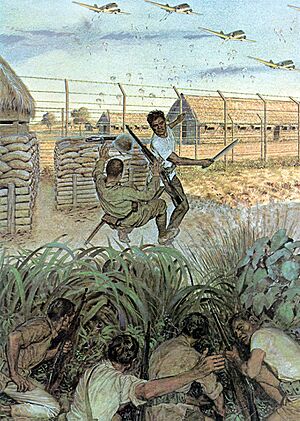
The Philippines was attacked shortly after Pearl Harbor. U.S. and Filipino forces fought bravely but eventually surrendered. Many Filipino soldiers were forced on the Bataan Death March, where thousands died. A smaller force held out at Corregidor. After a fierce battle, they also surrendered. Six Filipino officers who graduated from West Point were executed by Japanese forces, including Vicente Lim.
In the U.S., Filipinos were initially blocked from enlisting. But laws were changed, and many joined the U.S. Army. Two segregated units were formed: the 1st and 2nd Filipino Infantry Regiments. These soldiers faced discrimination during training. However, they served with great distinction in New Guinea and the Philippines. They received over 50,000 awards and commendations.
In the Philippines, some soldiers and units refused to surrender. They started a guerrilla campaign against the Japanese. They were later joined by other Filipino soldiers and civilians. Allied forces returned to the Philippines in 1944. In total, about 142,000 Filipinos served in World War II. If guerrillas are included, the number could be over 250,000.
Sergeant Jose Calugas became the third Asian American to receive the Medal of Honor. He was the first Asian American to receive it during World War II. Later, in the 2000 review, First Lieutenant Rudolph Davila's Distinguished Service Cross was upgraded to a Medal of Honor.
Korean Americans
Koreans began moving to the U.S. after a treaty in 1882. This stopped when Japan took over Korea in 1910. When World War II began, Korean Americans were treated as "enemy aliens." This changed in 1943. About 100 joined the U.S. Army, some as translators. Over a hundred joined the California State Guard in Los Angeles, forming the "Tiger Brigade."
Young-Oak Kim was rejected by the Army at first but later drafted. He served in the Japanese American 442nd Infantry Regiment. He received the Distinguished Service Cross for his actions in Italy. Fred Ohr became the only Korean American "fighter ace" of World War II. He shot down six enemy planes and received several medals.
Cold War (Post World War II)
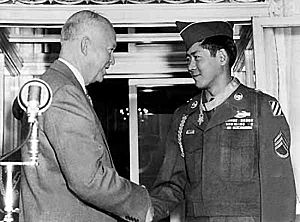
After World War II ended, the U.S. military sent millions of service members home. The 442nd Regimental Combat Team was deactivated. In 1946, President Truman awarded them their seventh Distinguished Unit Citation. That same year, the U.S. passed a law that denied benefits to Filipinos who served in the Commonwealth military and as guerrillas during World War II.
In 1947, an agreement allowed Filipinos to enlist in the U.S. Navy without needing immigrant papers. In 1948, President Truman ordered the military to stop separating soldiers by race.
Korean War
After Truman's order, most segregated Asian American units were disbanded by 1951. Many Asian Americans continued to serve in mixed units. The exact number of Asian Americans who served in the Korean War is not known. Of the 36,572 Americans who died, 241 were Asian Americans.
One Asian American received the Medal of Honor during the Korean War. This was Japanese American Corporal Hiroshi Miyamura. His award was kept secret at first because he was a prisoner of war. Three brothers, Kurt Chew-Een Lee, Chew-Mon Lee, and Chew-Fan Lee, all served in different units and received high honors. Young-Oak Kim became the first ethnic minority to command a regular combat battalion.
Vietnam War
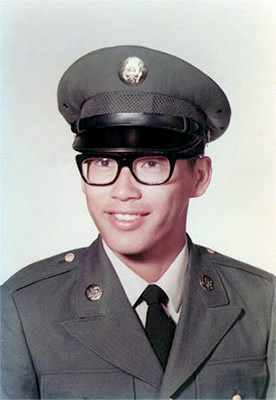
During the Vietnam War, 35,000 Asian Americans served in fully integrated units. Three of them received the Medal of Honor after they died, including Corporal Terry Kawamura. The Army also formed a special forces team called Team Hawaii. It included Chinese, Filipino, Japanese, and Native American soldiers. They could pass for Vietnamese and conduct long-range patrols.
Asian Americans still faced discrimination and racism. Their loyalty was sometimes questioned. Some were even mistaken for enemy soldiers and fired upon. The Viet Cong also specifically targeted Asian American service members.
Throughout the war, Filipino American sailors were still mostly limited to steward jobs. In 1973, these restrictions ended. By 1989, Asian Americans made up about 2.3 percent of the total armed services. This was slightly more than their share of the total U.S. population at that time.
Persian Gulf War
Many Asian Americans served in the U.S. military during the Persian Gulf War. Some held senior officer positions. Major General John Fugh became the Army's top lawyer. One Asian American service member died during this conflict.
In 1992, the U.S. Navy stopped recruiting Filipino citizens. This was because a military agreement ended.
The 21st Century
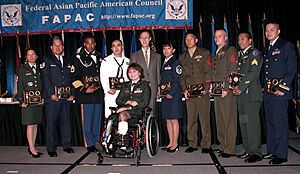
Today, Asian Americans, especially from California, are joining the military at higher rates than their population size. They often choose non-combat jobs. In 2009, Asian Americans made up 4.4 percent of Army officers. In 2008, Filipinos were the largest immigrant group serving in the U.S. Military. Korean immigrants also served in large numbers.
In 2010, Asian Americans made up 3.7 percent of active duty service members. They were mostly in the Army and Navy. In 2012, about 23 percent of the 65,000 immigrants in the U.S. armed forces were from the Philippines. As of 2018, Filipinos were still the largest immigrant group in the U.S. Military. Asian Americans are also increasingly choosing to become officers.
War on Terrorism
As of April 2017, 62 Asian Americans have died in Operation Enduring Freedom (Afghanistan). As of September 2018, 390 Asian American service members have been wounded.
Afghanistan War
Asian American Marines were among the first units to enter Afghanistan in late 2001. This included Pakistani American Marine Lieutenant Colonel Asad A. Khan. In 2011, Private Danny Chen and Lance Corporal Harry Lew died in Afghanistan after being hazed. Several unit members were later prosecuted. Also in 2011, Petty Officer third class Jonathan Kong risked his life to save a wounded corporal. In 2014, Kong received a Silver Star for his bravery.
Iraq War
Hundreds of Asian Americans served in Iraq. The 100th Infantry Battalion was sent to Iraq in 2004. This was their first deployment since the Vietnam War. They were authorized to wear the 442nd's shoulder patch, which was a special honor. The 100th Infantry Battalion was deployed to Iraq a second time from 2008 to 2009. By the end of the conflicts in Iraq, 78 Asian American service members had died.
Leadership
The first Asian American general was Brigadier General Albert Lyman. He was part Chinese and Hawaiian American. He was followed by Rear Admiral Gordon Chung-Hoon, the first Asian American flag officer. The highest-ranked Asian American is former Secretary of Veteran Affairs Eric Shinseki. He was a four-star general and the Army Chief of Staff.
In recent years, Asian Americans have been well-represented at military academies. For example, Asian/Pacific Islander Americans make up about 9–10% of classes at West Point, the Naval Academy, and the Air Force Academy. This is higher than their share of the national population.




